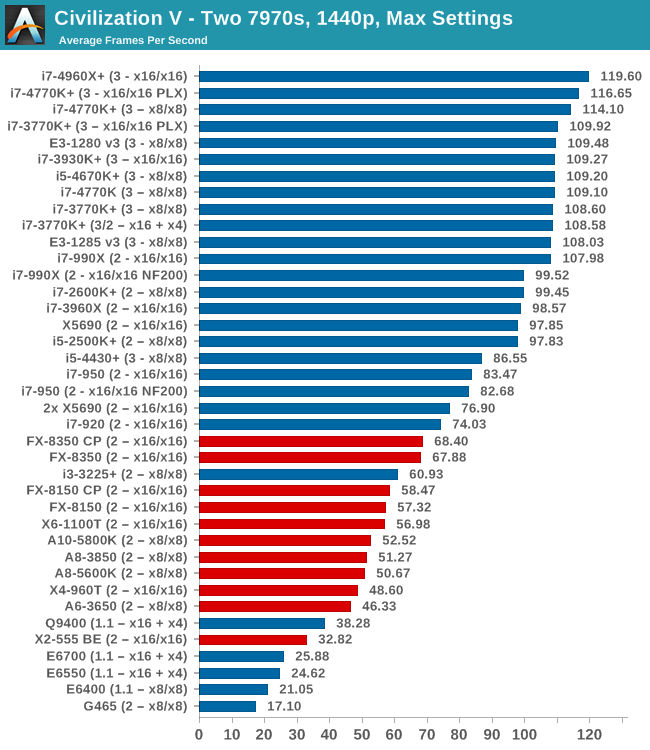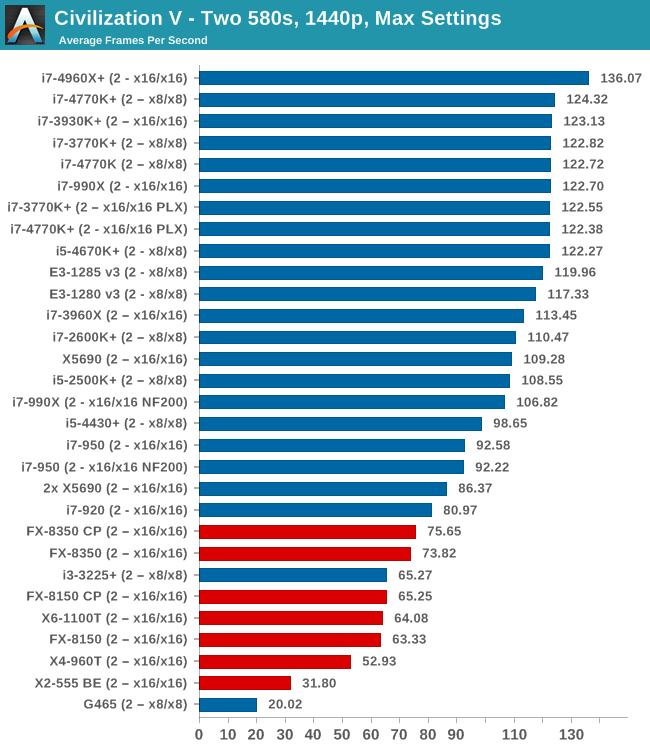Choosing a Gaming CPU October 2013: i7-4960X, i5-4670K, Nehalem and Intel Update
by Ian Cutress on October 3, 2013 10:05 AM ESTCivilization V
A game that has plagued my testing over the past twelve months is Civilization V. Being on the older 12.3 Catalyst drivers were somewhat of a nightmare, giving no scaling, and as a result I dropped it from my test suite after only a couple of reviews. With the later drivers used for this review, the situation has improved but only slightly, as you will see below. Civilization V seems to run into a scaling bottleneck very early on, and any additional GPU allocation only causes worse performance.
Our Civilization V testing uses Ryan’s GPU benchmark test all wrapped up in a neat batch file. We test at 1440p, and report the average frame rate of a 5 minute test.
One 7970

Civ5 seems to love IPC, with our Haswell and Ivy-E CPUs all near the top. All our PCIe 3.0 combinations hit 80 FPS or above.
Two 7970s

On multiple AMD GPUs the PCIe 3.0 combiantions get the biggest boost, along with anything using a PLX or NF200 chip to boost lane allocations. There seems to be a barrier around 100-108 FPS that only Haswell and Ivy Bridge CPUs are moving over, except the one 990X result. The i7-4960X takes top spot, and the i7-920 is 45 FPS behind - almost 1/3. The i5-4430 is lower than expected, showing little scaling after the first GPU.
Three 7970s

Civ5 has terrible scaling behond one GPU let alone two, meaning most of our tri-GPU results are similar to dual GPU. Again, anything purely PCIe 3.0 seems to get the biggest boost, with the 4670K still fighting alongside the 4770K.
One 580

For a single GTX 580 the top spots above 80 FPS are all on the side of Sandy Bridge and above, with Nehalem scoring below this marker. It seems that dual core CPUs take a bashing, suggesting a quad core minimum.
Two 580s

More NVIDIA GPUs for Civ5 means more cores and more lanes where possible, with the i7-4960X taking the top spot. This is almost 40 FPS higher than the i5-4430 and the Nehalem CPUs. The 4670K doesn't miss a beat against the i7-4770K.
Civilization V Conclusion
We see some of our biggest variations in CPU performance in Civilization V, where it is clear that a modern Intel processor (Ivy/Haswell), at least quad core, is needed to get the job done for the higher frame rates. Arguably any high-end AMD processor will perform >60 FPS in our testing here as well, perhaps making the point moot. For single CPU, the i5-4430 performs well in Civ5, though in dual GPU the i5-4670K might be a better investment.










137 Comments
View All Comments
BOMBOVA - Sunday, October 6, 2013 - link
a low cost raid controller yes, 64kb, 128kb, show the merit of raid 0, at 6 Gbs each, i was doubtful myself, but took the test of the device, for i need better video editing performance, at least it works :) now we have to watch out for the 12Gbs devices coming soon, imo for games, not much notice of improvement to be seen, but in big data transfers, sata 3 improvements, can be had for low costs. gl, trying it out, borrow a card to try, if you can, Cheers.BOMBOVA - Saturday, October 26, 2013 - link
fact is you can set to 32 K blocks, or 64K, 'only" , but is a true Marvel controller chip, in the Syba, and is on the PCI e buss. , Control M, sets the chipset, works rite off, is quick, but, there is a hint, that the lanes are only 5 Gbit second, still is a fine patch upgrade, on low cost 6Gbit second ssd's i am in for 2x120 ssd's and controller for 250,R-Type - Friday, October 4, 2013 - link
Results are typical for a variety of games where the resolution is set to 1920 x 1200. Games include Dirt 3, Civilization V, Guild Wars 2, Mechwarrior Living Legends, Diablo 3, Starcraft 2, etc.augiem - Friday, October 4, 2013 - link
I'm really kind of shocked to see how well Nehalem stands up still in many benchmarks. If you adjust the i7 920 benchmarks to make up for the difference in frequency between it and the 4770K, it's not half bad. I used the difference between the i7-920 and i7-950 to determine how the benchmark scaled on Nehalem. If it was close enough to linearly (+/- 1%), I considered it. I saw a 6% - 40% performance advantage for Haswell across the CPU tests, which is actually smaller than I expected for an almost 6 year old chip. (Obviously this includes differences in the platforms too.) Striking that even in 6 years the speed hasn't even doubled.I'm still on an i7-920@3.6, so this was very relevant to me. If it were 40% across the board, it might be more compelling, but quite a few were more like 15%, 20%, etc. Now I understand Haswell is going to OC a lot further than this one, so in that way you could get the performance diff up there.
I'm just dumbfounded that this Nehalem has lasted me 4.5 years already and it still doesn't feel slow. On the one hand its great value for the money, but on the other hand its a little disappointing to see performance curve drop off like it has over the past 6 years.
That would be a fun project. Make a graph showing average CPU performance increases over the last 30 years.
Genericuser1234 - Saturday, October 5, 2013 - link
As interesting these chips are for getting maximum performance from the high w parts. Will you do an article about the low TDP parts that are the true masterpieces Intel makes. I live in Denmark and energy cost more and more. My PC is running almost nonstop and I am curious how well these chips perform in a gaming environment. How far behind are they on performance and what kind of power cost on a year based on an average workload / idle time are we talking about you could save. I find the low power chips to be Intel's true stars. Do more with less. Maybe even throw in a power house chip from 2 years ago for comparison. That would be an interesting articleagent_x007 - Saturday, October 5, 2013 - link
Congrats to those who did testing part.Can't wait to see AMD added.
Too bad Pentium XE 955/965 (ie. Presler B1/C1 @ 3,46/3,73GHz) didn't "cut it" for this comparson :(
Hyper Threading and "Last of Netburst" legacy could be interesting in comparison with low end, fully-intergated setups, like VIA Nano or AMD Fusion.
+ There is also a possibility that todays multithreaded programs would better utilize the 4 threads of this kind of CPU, maybe to the point of matching Core 2 Duo's...
Either way, to sum it up in two words : GREAT WORK.
khanov - Saturday, October 5, 2013 - link
A good article, and nice to see an update now that new CPU's are out.Wouldn't it be nice if you could have all the benefits of X79 for multi GPU configurations, but without the added cost over Z87? Well actually you can, if you take in to account the quad-core LGA2011 CPUs.
The i7-4820K is no more expensive than the i7-4770K, and motherboard costs are very similar too. So people seriously considering 3 or 4 GPUs might be very interested in this option, to gain the benefits of extra PCIe lane allocation without the extra cost of a hex core CPU.
Ian, would you please consider adding i7-3820 and/or i7-4820K to the next update? It would be nice to see how well, or how badly, they fare against the competition.
MarcHFR - Sunday, October 6, 2013 - link
Hi all,Sorry but i don't understand this review. What's the point of recommanding different CPU on the only basis of single/dual/tri/quad GPU ?
First, the GPU power is not related to the number of GPU only, with 2x660 you get lower performance than 1x780, but if i read the conclusion for 2x660 you recommand FX-8350 but A8-5600K for 1x780 ?
Second, for example with only a 7970 with a small CPU or a big CPU you get exactly the same performance on Sleeping Dogs 2560*1440 max settings. But what kind of player will keep a setting that offer 28 fps on such a carde ? None ! They will lower the graphic settings related to the GPU only to a point that they will get a higher framerate, like the 80 fps you get with three card.
Whatever the number/power of the GPU, as soon as it's not a lower-end card, the CPU needed to get playable framerate is the same with a GTX 660 or 2xGTX 780 as soon as you don't use graphics settings related to the GPU that lower the framerate that can be sustained by the GPU under the framerate that can be sustained by the CPU.
You can recommand different CPU to get more than 40/60/80/120 fps in some games (but good luck since integrated benchmark are generally not using the most CPU bound scene), but recommand different CPU for single/dual/tri/quad GPU seems a non-sense for me.
Majesticii - Sunday, October 6, 2013 - link
Damn. How can you call this a CPU comparisson with data like this. The games are run at such extreme values that in no way they represent the impact of a CPU. Sleeping dogs is just 4 graphs with 28fps, how can any respected researcher show this data without severe shame. To add insult to injury, the vast majority seems to think this is how CPU tests are done and call it a nice review. Literally my heart sank as i read through these comments. Noone (except a few ignored), not even the reviewers has a clue what they're on about. This way of CPU-reviewing in games needs to stop. This isn't just uninformative, it's worse; It's completely misleading. Test games at 800x600 low settings, and pay no mind to those people calling for "real-world benchmarks". Stay true to what's real, instead of appealing to the community.3Ball - Monday, October 7, 2013 - link
Forgive me if this is pointed out in the article and I have missed it, but it is worth pointing out. Battlefield 4 will use up to 8 cores/threads. My i7-860 @ 4.0ghz with hyperthreading is outperforming a friends Ivy bridge (3570k) at 4.4ghz without hyperthreading, so much so that my frames are better using a GTX680 against his GTX780.This could be the product of the "beta", but I do believe it is a sign of things to come. The new consoles are most likely going to influence multithreaded performance greatly considering the lower sinlge thread performance present in the systems.
I have been planning on rebuilding with haswell early next year and was planning on getting a 4670k, but have now changed that decision to going with a 4770k due to this experience. Just my two cents. Cheers!